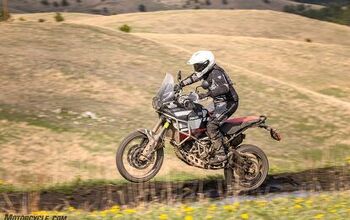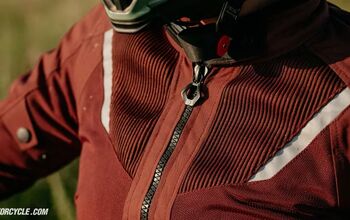Alpinestars Tech-Air 7x Review
A-Star's latest airbag system wins over Mark Miller
Equipping a motorbike racer with an airbag system sounded like an absurd idea the first time I heard about it twenty years ago. What, was a big white beachball going to blow up around us as we embarrassingly bounced past some fans, then ricochet off of one wall to another? I could only imagine myself finally rolling to a stop, my feet still kicking out from the bottom of it, shouting over muffled laughter, "Hey! Is anybody there? Help! Corner Marshals? Somebody get me out of this stupid thing."
Two decades later, I found myself testing the Alpinestars Tech-Air 7x, the most advanced consumer motorcycle racing airbag system to date. An additional feather in the ol' MO cowboy hat was that we'd be evaluating the new Tech-Air 7x at The Circuit of the Americas in Austin, Texas, just one sunny day after a gang of Alpinestars athletes went on to win every MotoGP race during the weekend, in all classes, including the King of The Bagger support races. Each of them wore an Alpinestars Tech-Air racing airbag system.
Yeehaw!
To be honest, I didn't have a lot of experience with airbag systems until now. I stopped racing full-time just as the technology became widely available, and for years after remained a curmudgeon toward change. 'These young whippersnappers today, always fussin' over protecting their hides. In my day, we didn't duct-tape pillows around our britches or rely on microchips to tell us how to eat dirt! If we got thrown off a horse we'd go have a shot of whiskey and eat some potato chips.'
A couple of years ago, I received a beautiful one-piece integrated racing suit for my birthday. However, I was so appalled by the added weight from the airbag system that I spent the first hour with my expensive gift not cuddling it, but removing every last remnant of the airbag system. Sorry babe!
During my racing years, the team and I would sacrifice anything to shed off a few grams from the rider or bike. I therefore couldn't wrap my head around carrying the extra pounds just to aid with a softer landing should I come off my bike in a vicious way. If it wasn't in the rulebook forcing me to wear one, I'd take the risk and stay as light as possible. It's motorcycle racing, not recess at school.
A year later, I was loaned a lightweight Alpinestars Tech-Air 3 vest, designed to fit under or over any street riding jacket. Unfortunately, just as I was growing fond of wearing the system and feeling naked without it – like forgetting to bring a helmet – the airbag deployed after I slipped it over my shoulders while taking it off, even though the system had been technically deactivated for several seconds.
Your history with rider airbags? Feel free to leave a comment.
Despite my first spotty encounters with this technology, I remained airbag-curious.
Backstory
Leading up to the 2008 Isle of Man TT, Alpinestars asked if I would wear a unique set of data-logging leathers, enabling their engineers to record the brutal forces acting on my body as I navigated the most violent racing circuit in the world.
The leathers featured a wire harness stitched into the inner liner, with fine thread-like cables running down the arms and legs. Accelerometers, gyros, g-meters, and a GPS were stuffed inside the aero hump behind the rider's head which could capture electronic data across entire 38-mile laps.
I thought the whole thing sounded awesome, so I agreed.
The two Alpinestars nerds assigned to mind after my bionic suit for the fortnight were eager to gather data specific to the TT, aiming to identify the widest possible envelope for a defiant superbike being pushed to its limits, without actually crashing.
Fortunately, I didn't provide the tech experts with any intelligence too unusual, such as what the suit might record in a graphic fatal incident. Although that thought had crossed my mind.
The coolest part of the whole experience was sitting down with the clever lads from Alpinestars after a race to watch a real-time playback of a virtual stick figure mimicking my exact body movements from the bike, just minutes earlier. My avatar was tucking and bucking and tank-slapping with its elbows out. It was strangely endearing to watch.
I have to add that all of this astronaut shit weighed a ton, and we weren't exactly racing around in zero-gravity! Except over the jumps.
I never complained.
Only later did I discover what all the fuss was about surrounding my electric horseman suit... Airbag development.
Timeline
Since 1963, Alpinestars has been producing safety gear for motorcyclists. Today, they own a massive in-house test facility in Italy where they evaluate helmet safety, armor performance, abrasion resistance, waterproofing, fireproofing, seam strength, and God knows what else.
As far back as 2003, the Alpinestars R&D staff began collecting data for their evolving airbag concept. In the coming years they gathered an exorbitant amount of diagnostics from millions of road and dirt miles, endless circuit laps and thousands of crashes (none contributed more than Marc Marquez). The end goal was to code proprietary algorithms intelligent enough to decide in milliseconds whether a rider was saving an abrupt slide, or eminently crashing.
In 2009, six years after their engineers began logging data and only one year after my minor contribution at the 2008 TT, Alpinestars delivered their first-generation racing airbag system to select riders in MotoGP. By 2017, Dorna made them mandatory for all riders across all classes in MotoGP. In 2018, the rule was expanded to the World Superbike paddock.
By 2024, I was excited to try out Alpinestars' latest Tech-Air 7x racing airbag system.
Back to the Present
For my COTA track day, Aprilia generously provided us with a fleet of RSV4s, Tuono V4s, and RS660s to use as our test mules. Mind you, this wasn't an invitation to challenge the inflatable armor of our new Alpinestars Tech-Air 7x. But these high-performance, street-legal machines are formidable weapons of war capable of tearing through COTA's fast corners and long straights to better understand the Tech-Air 7x’s comfort, maneuverability, and mass while navigating this MotoGP circuit in a somewhat serious manner.
Upon first handling the Tech-Air 7x, it had a reasonable amount of weight yet remained slim and contoured. Made in Italy, it exuded quality and attention to detail.
I unpacked my Tech-Air-ready Alpinestars one-piece leathers from my gear bag and left my usual chest and back protectors behind. I slipped the Air-Tech 7x into my suit first then stepped into both the airbag and the suit together. The totality of the safety gear enveloped me like a fine fitting glove.
Once on, the suit didn’t feel any heavier, and there were no restrictions to my movement as I stretched before my first session. The soft thermoplastic polyurethane (TPU) molded rubber surrounding the passive hard-shell Level 1 back protector fit snugly, and the adjustable retention straps behind the rear bladder hugged my ribs. Sturdy elastic bands at each bicep were helpful at keeping everything centered throughout the day.
I soon set off down pit lane and spent several hours in knee-dragging bliss, surrounded by industry journalists, MotoGP star Miguel Oliveira, his father, his teammate Raúl Fernández and Aprilia team boss Massimo Rivola, who can ride impressively fast! His team, with Maverick Viñales, won the Sprint race as well as the main MotoGP event, so the Aprilia Capo was in a good mood. We shared a nice scrap early in the day before I picked up my pace. Heh heh.
Having the Tech-Air 7x zipped up around my torso never distracted me from our on-track shenanigans, despite the hot and humid Texan weather. The airflow through the laser-cut front bladder and perforated vest was excellent, and I never felt like my enthusiasm to keep riding was squeezed out of me by the clinging airbag system.
In fact, I felt more confident knowing that this 'third eye' was monitoring my every move at 1,000 times per second, detecting shocks or unexpected movements that the AI-leveraged microcomputer built into the 7x would consider abnormal for circuit racing. And if need be, explode into action by deploying Level 2 active armor in less than a quarter of the blink of an eye to protect my chest, collarbones, spine, and tailbone – essentially saving me from myself. How often do we see current MotoGP riders suffer from collarbone injuries these days, for example?
It’s pretty cool to find another thing in this crazy world that’s designed solely to protect us, even when we refuse to stop tempting fate by riding our motorcycles at ridiculously high speeds.
In Conclusion
Igniting the pyrotechnics of a Tech-Air's Argon gas system in a timely manner is no easy feat, and should never be taken lightly. Considerable care must be exercised before possibly introducing a controlled explosion of inert gas that is affixed to our bodies, especially when some of us flirt with speeds of 200 mph on a weekly basis. It's crucial that we remain in control of our motorcycles at any speed, despite the introduction of yet another electronic contraption into our lives.
And of course, modern airbag systems are not enormous pillows that engulf a rider fully in the midst of a crash. There are strategic areas which the expanding bladder focuses on then deflates again quickly.
We were given a demonstration of the airbag deploying right in front of us in the room and it is truly an instantaneous "BOOM". There was even a remnant of that old 'cap gun' smell from our childhood left in the air.
However, my research and firsthand experience with this now refined technology has left me reassured. Due diligence has been taken to ensure that not only will the airbag throw us a lifeline if needed, but also make the decision to wear an system an easy one, when considering comfort, cooling, flexibility, and the all important weight.
The Alpinestars Tech-Air 7x ticks these boxes for me, and going forward I plan to ride with mine whenever possible. I might even encourage any passengers who'd join my ride to wear one, as well.
Back at the Ranch
I'll include a quick draw of details on the Alpinestars Tech-Air 7x below:
Tech-Air 7x Airbag System Features:
• Includes two user-changeable gas canisters.
• The system can deploy once, remain inflated for 5 seconds, and quickly deflate through a release valve for continuous racing.
• Most serious impacts happen within the first 3 seconds.
• One canister can be removed to reduce weight, allowing for only one deployment.
• Each canister costs about $100, but current street price is $169/pair.
• Recommended to send back to Alpinestars for bladder inspection after four deployments to maintain integrity.
User Interaction and Maintenance:
• Waterproof lid on the back unit allows easy access to canisters.
• All components, including bladder, canisters, and electronics, are user-removable for washing vest.
• System easily reassembles after cleaning using color-coded indicators.
Protection and Certification:
• Incorporates a Level 1 hardshell back protector that absorbs impacts not requiring airbag deployment.
• Offers 90% more impact force reduction compared to a standalone Level 1 back protector.
• System offers protection similar to 18 Level 1 passive back protectors.
• First airbag system certified under European Regulation to deploy before first impact.
Compatibility and Integration:
• Replaces the original Tech-Air Race, with better cooling through a split front bladder and zipper.
• Features removable front zipper panels for integration into older Tech-Air Race ready suits and jackets, or can work as a standalone system with adequate space.
• There are identical velcro patches as the Tech-Air Race to secure the system into a previously integrated Tech-Air Race suit or jacket.
Operation and Technology:
• Operates with a fully charged battery for about 20 hours of active ride time, recharges in four hours. A one-hour charge provides 7-8 hours of riding.
• Features easily accessible USB-C port on front of vest for charging and two magnetized Velcro tabs for On/Off.
• Includes color-coded LEDs to indicate mode and battery status, with optional LED rerouting to compatible Alpinestars apparel.
• Equipped with 12 sensors, including tri-axial accelerometers and gyroscope, to cover movement in three dimensions.
Tech-Air App and Connectivity:
• Offers Bluetooth connectivity through the Tech-Air smartphone app for checking system status, battery life, MyRide trip information, and updates.
• Pairs with the airbag system via a QR code on the vest.
• There's no subscription to keep the system operational.
• MSRP: $999.95
Become a Motorcycle.com insider. Get the latest motorcycle news first by subscribing to our newsletter here.
More by Mark Miller












































Comments
Join the conversation
Hmm I'm a little worried about the reduced chest protection vs the previous model.
I wear my tech-air 10 daily for commuting. Unfortunately I've already used it once, but fortunately it did it's job